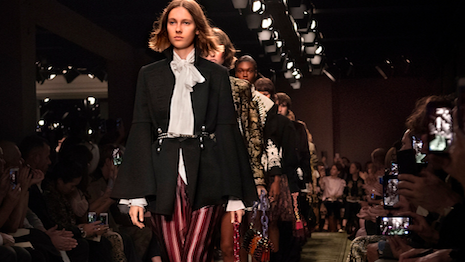By Ana Andjelic
The fashion week month is in full swing. New York Fashion Week just ended, London just kicked off, and Milan, Paris and others are around the corner.
At the ongoing London Fashion Week, which started on Sept. 16 with a posh reception at 10 Downing Street, there will be 83 designers and 5,000 guests from 58 countries.
Many more will watch runway shows streamed online, devour Instagram images, follow Instagram and Snapchat stories in real-time, buy runway stuff immediately online and follow the happenings on Twitter.
Hash braun
If the past couple of fashion weeks are any indication, the Internet is about to go crazy.
In 2015, #NYFW was used a whooping 31.6 million times.
Last February, there were 113,348 images tagged #LFW on Instagram.
A week ago, Rihanna’s #FentyXPuma hashtag alone enjoyed a 35,000 mentions spike after her runway show.
Snapchat numbers are always hard to come by, but this platform's 10-billion daily video views were impressive enough for Condé Nast and Hearst to launch their dedicated their Snapchat Discover channels.
Most designers are expected to show their SS17 collections. Some of them do that secretly and in private for a few selected guests.
Others focus on their AW16 collections, instead opting for in-season relevancy.
Yet others create massive marketing spectacles, such as Tommy Hilfiger’s 40-foot Ferris wheel.
Burberry, ever a trailblazer, will debut simultaneous womenswear and menswear collections, both of which will be instantly available in-stores and online.
 Ana Andjelic
Ana Andjelic
This will very likely go down as the year of the Great Fashion Week transformation. It will also go down as the year of tentative experimentation and cautious creativity, both in the formats of runway shows, business models and marketing actions.
At an uncertain time where everyone in fashion keeps a watchful eye on what others doing, here are the three things that stand out.
Direct-to-consumer. Also known as see-now buy-now, this model is fashion industry’s uneasy response to the ubiquitous on-demand economy heralded by Uber.
Across the board, consumers expect seamlessness, convenience and immediacy, and fashion turned out to be no different.
Rebecca Minkoff, Burberry and Mischa Nonoo were among first to transform their operations to adapt to the new rhythms of consumer demand.
In the process, they also successfully broke up with traditional fashion media and marketing.
A press release and a Vogue spread simply do not cut it anymore. Successful runway promotions revolve around Tidal and Apple Music partnerships, hashtag programs, micro-actions such as Instagram and Snapchat Stories, live social media campaigns and shoppable content.
Mass access. While Paris, Milan and London still nurture the cult of exclusivity around the fashion week, NYFW has opened its doors to fashion fans as well – a trend that is likely going to spread around the globe.
From Givenchy’s celebration last year of love-themed mass event to Kanye West’s Madison Square Garden album-release-cum-fashion-show to Opening Ceremony’s aptly titled “Pageant of the People,” New York is showing what runway is going to look like once it loses its role as a buyers-and-press affair.
In the ultimate digital-meets-physical extravaganza scenario, Tommy Hilfiger mixed his Tommy x Gigi outdoor festivities at South Street Seaport in downtown Manhattan with on-site digital touchscreen shopping walls for those rushing to buy the just-seen looks and with the Facebook Messenger chatbot.
#livestream. If you do not happen to have a thing for the front row – or any row for that matter – you can still instantly watch new collections in any number of ways.
Instagram influencers’ photos, outdoor live streaming and virtual reality are all at hand.
Facebook Live is Vogue’s favorite as is Snapchat Discover, launched just in time for the fashion week season.
Sweet is Hearst’s bid for relevancy among the young fashion crowd. These days, it seems to be harder to hide from a fashion week than to see it.
In a situation where there is a serious danger of over-saturation, smart brands should use live streaming to enhance their narrative, not to spam their followers.
Just as the entertainer exclusively released his latest album on Jay Z-owned Tidal, Kanye West exclusively streamed his Randall island-situated fashion show there.
In the extension of its iTunes liaison, Burberry continues its partnership with Apple TV, which is likely to evolve into some form of real-time retail model as this brand’s runway items become instantly available for purchase at the current LFW.
THE COMMON THEME of fashion weeks this year is creating a close connection between consumers, brand narratives and products.
Smart brands are using their fashion shows to design experiences that seamlessly tie in storytelling with retail, delivered by technology and driven by modern fashion consumers’ expectations. This is not likely to change.
Ana Andjelic is senior vice president and global strategy director at Havas LuxHub, New York. Reach her at [email protected].
{"ct":"9dC6zqwLI4Rq1KHLnnBduxU7yUFm9S3luXft4isdBuM9WfemajhHP8QnUyCRFlkDGYyT+bVZHCHtYQrOZVmtlGujyJm18QhI6fZObTugTqAfjRl8XwId3hUCYKJjnxhvzGTahSsaRWVG2J0FqxodfovYYXX9PjItG9emd+7cm1a4Sqo9TGbZtFSbsz6J+vXftrlIH5TFHKGJse7OerxvM8jRMcBrvUJD90loznuHfyO1BfGjth0DJQTVPMMfAB47OX6kgSUVM53f3Q7KPWkZF\/08z84Ti+k9JvgsUTzZI9lZ3nho\/UkkJmthSA76iof4Rqsk6aWjegAppkEwqFS4l65k69Hj1oO9\/er+3W3qOBx2Yy3Oof+SPr3MF00TDmV3NSZ4k64YcrybQULB7Le12GkO\/+ZOXIJZjnkkLLwfCKFIRr1FU9L7zRT2pY9mEDJdOlWpRfmDgYP\/qEebOtAsz\/Tc1az1UuTMHaY7Vx\/znkxVAkrGIG+L6OZ6SQK61GT9nxsgBs5tcuwHT2dQUXQB7dNTJh2WYEQvTdbUirJ3PRRnC6eJhH8qC7VPXfPOemO7ugIaX8ct19uuaNPjXQHoB2RXdTnprsxXJE4WIj+24ecwXPBiv7Vkw0vdeifio2dyRYtcwEUHZZphFq7yZ+UGg14bzf5888FhyNNH2nIL5DqAGa2GtfztGlLvSyxd3OeAPlJhfbjLud9BUq537CNPN\/1oo9pbUgEFZy6Rqiq9rjmDs3bK2NSH5fgqGLHMYhI2o8Q0RlLbQ72ikNwxj5VDI5FlqBvIzot5WkYuucpsas11TsMsxC+SZIb8noMZeo09QySUMIgv4IUtkfnaP\/FmLnyhahiU2nJSdAJXYbX0C0ydG4KEVK8ftw\/OZGaZqkKNWFV3o3GK0vxwCXsFdwT5C6UKiyrUlnj\/QILpXrevr4PvPRI4zk3QI+nakAGnsXldk7Tz54fjtmEn3z6ecdblo+tIkcnMH+zZaG\/ue6IC4U85ZkBvbuKS8rGW6aGezkWbDe9v+R5WOomB8QIXB\/m8qxLgFeSRIJEzd8vw4Llmzi7kFoL+a1qM1NvwiN4wMM4FKvzgS1mBkWhMI9tV9Axfug\/AgY0TtqBFexXoaEvfWg4NMN6p\/UO1jQWgYG3HH1JTgz+Cl637fKPIrTJZhrgoiJN4sfehGPayGcoBZlbe19uVQcuSU3VopHuK2Smoe2iah3eFciVZYRp7NtBuRXz2g457q8Fqnj15+toTfIbXQXp9c0+WXQAJcbEZsG0THHcBn037vj3QElev5jQmOY5Kph++wxPT++k5aZob5\/UaYueoxGjgw2MEjPyCd4044tyunmUct8TcC0SrIWOV9i3ZHV3uUm2XmS1nQ7tQiUDDbi+pyphpZRqwQoUF\/LF4ctEltw+x65mZUujlVhh7I6+bQv64XOwicV6kBHVNB5On8LNDawL9WNd+yUhJxU6UoNDUYu4ZlR0MgdNNnv1XFYlCXwzLQ5cHXd7esyaJkozaSPUeCuK3H9H+xCHQESdJVApV+bt2MbSuQDs9EsQ7mkPDNPtMhEpSlcJq4PVupQLY9Z3OiU3G3dH2mE+mtjr2HPJtw9htiw0PyaA0ukVwt11unccXos3a5+Rjjor7MSPfyOI3oPlosAlQ6NGz5T2C8TEe602n2vsXkhOJl5r1M9hhbZrfp6rdSdaJiSSkAq2GIJaDHyXxTk3ubOv60bikT4LAiBwjzrYblDtGj6EYboZ0npU8UJGC0x+MKvnk3QZXn9AnwvGBP5Al2QFlkELubc1Sbtvhjd4ll9EoDTPPHtS+5uVZtD6zzrQB5TzV7mRa4eyQlE5wh5Lnncu1Tf8UEnc\/s1BcX+946xuzY1NM8+97tdje8tBR2r2wElNJuNpa2PgRd4eJk2Puc1Zqi2VKH2IvPrm1DamZ\/cK+W5l3cr20d1mDBut9slvCQk6\/Ss9oG9f6ecfEvTR\/+mUz14GFJG0OGzEUSp+4Ckn+zlNqfAQQu2\/Skm7Hc8x5xolqmd5EzK9pAnJf3Qk76VMyQiT0RhZzLDVpREBx6K9k4W53eSHgbnyoib1RJvA5KFGWAKyxnkVmVFYu6MxFFsHA0gQZCdLzUflw62Iw3jP40JqrPvaW4EVpDTjoYstczrZ61pFirZYCCfZ6lTi+o\/Eof54Ctu0wKfigS7wW2e2RI\/dz+UKCXud49d2kTji9W1KNYGBbPXr0Btt27oSvdzRD+rb\/l52DZGb6yG\/95egOTtDocitCR0YSu56AteFBzXdOkbiFGMoF1vSZgxNRGcQ8o7gh6EMcxEe7+bS2c6HCxEFUiiYgC3r6DnDBf1U8fDjlULbEau45GsuMmZD\/6qio3FSaY55S8z41b3VzubxFAZtQh5foA8rU9CaaG5qgxPS8Hs2aVZe2vBhsDm\/te3gypK1eVuExPYPWGAK+jG3rWt2DC9QdGtJPiM6MeMY0UsoSfAbnmp7qDujDxxYJUOpvnRnqZ0fivuXNxMFm9n+TBbHURVXOwdYNbBoFfHsTWefDcNv93CDwukGVYz2bR2xlDZAHsntA6vPEQnODH8Ugsd2YQU43ZtY1Lf0yv\/sW9igJBE+baF2WRNUNl4UdLx1Qt234a2pDv1JkAMNbDnjpXC18j24+L\/v3yokyxZcOmMLkEc+rVtqOj1pAWgDN7Drdt33+bw6Tl2vSZeAk5iuafMyJCsqVLFMFB1N+a\/BjQ81Q\/XpUFmTWm7w5uYptu0BrBC8RPuBkfvwv4nXg1xU4oTccRzkCsPtsVFsvllzHDQodaWbUXoSBbvJ4j8lA4r5JPuUG3MQwMTjDru1oF8uT6F3DMBKe2E4XXIdFjwUs1OQZ68PEkBZ07V\/H2tzkmTU7Ttz2IdEpyFsitra0pIhFX00X\/wb4zycKz54yPJl0ehVgD6SNxhKHCpI\/cV8KymzhIbUGvbOLqldHLFbtuYjJHfKInX3xyunSOlBaejqf724Vv7+jWTXjTHt5xuLKltn4Nx1dCYSmv4bWM8\/roepIbX4oWdl596dnR7wMr7bORWKS7Yy4YPT48Wq\/PxVUbyrLL+V0p+Ow3F9trXP7zdAm+6U2IZnRyEo674d82jMgFroM\/SyztHmOEHt19Wv1BGfXB+W8WgFdTLBBIj0u\/p67oVxsIVlBa3jcGld1xHourJbMJPELCKAP6EQ\/BUrI8sDlyRPf6\/9z0ZsTli\/LqJFl0829Q7UN5uddvxM7bCiqOIvYKx8OTDFmiHp7XkH07OQGZSp0orgi2iMrw4QfuVUKYIz5S6uL2JKfkqdGTnGEW+8uUe9Avnwnr1C9HkhJATDlnFw+tcx8SyGk\/RYRxHg9b\/W7BQX7a7rf+dyhjSaKcdjjD6eqQDaYClgSJbTeTDKg6Xmsr9BOD5+Tci8ZYnVzBCag+KrDx6QyBMYKxHTZ+IVkC6+bMz5BCuBY0Lot8Qy3k\/ppKitxUDpF\/G0qYwVihScI9utVw1upBBw3MEFJSHzTHYA3qQfM83HGCNNJdet0U\/AX84Dz7WhDXVbpEErfRxplMCJHP9lY9jdpOgJGg\/87GxNK9ChN54uQ2KmR9ZDG2YrMypqUbvOiOZ+X0jd2nWkdrzoQxrsOfHzSbW5+G1EhBpb5P8EyLseOh1ekMi0qLOq4\/aNLswcVFmsNdDCHDzY8Lai3J2e6mqgqsaJksdIwMz9W6Z1fI\/jV64bS1OLWL3RR5UB2YQAEXlfEHNgcbIhy50f1qXvJ5RcAIJ1iSL7LCLJrRE9apLkVmSS7u8n1\/ZQOq01\/v7+gCLccOD3mKD\/bj\/9rzXfkNxH+kMGGUh5XRZpxBEu9FNRCwP4m0gKdzqg6eHLOUf12Was1KM3+oFkCk1NKtNycSn\/WToeD1aOEl1mwjFUMpuMu6vDCmfa+LPFoN6IetWewlNEeqwZs6a3Re5dN8TvjPLxH7mTVGBvGNEfid\/q4iG\/d+yJYQSmu2a\/ayBRbLFtR0t8pM28tiON\/JouNVg1X5vEGeyhaAoifFdAsoWV9yJLtsSLAoojhTj0Q5xjWJv73opfKUhSHpCEWkAbQUljzFosiwuaCPLCGLuYRYEOgabS1DOgOq1IwSAjf9x\/uW5fC+Az\/M0GVLpLM4DqiCMxIC0OolA3PaLF+mub8DlMcxmHo8EEbaKOKWJF+RSTMAn15iDxeJ81rp3ijfBamo4c5Fw4DnfAHGpwUx2EQngOB3LQo3sBHq8BLKj+aTlQjeWWlhVWpugNR4XSkGj9+8YSoGpSN3Ocb6wNxEX+zD0yNti1d72DzO5CEplzdu0l8\/VSKNwH996zVJSQJQY+RX0v+\/CC9GgKNXQ3b7mdklGKxiKtculE6qSm519NTF7AarVEyDqTagwALHcIXVziYl1VvVASm7WQCc5wZ7RmPQcpe+8s8j\/J0JcRHFhhippEJEgqU1IZdvM8ZutrBekVGjzYzSuevw3cs+ZKFuw5F\/hrjb4sLIw+uWCwCgNYn5cn7vQxen5L8lzEDi08RbnYk0mFygI0bwdVmRLSeHUjEM+vWLCERlo7b37jFbbm368sp7gdZ9+iMsX1RtRDFVH3auofx\/bnUEU2ivEzmQmiU3Lt2ZWIyMaUZq57PeI67MSzhq79mZnFCORbmfDmjShJv2ZrANDZxHXc5irKJXEO3YHyE7wBuiRpqrPOdP7hXtAV+61msw35zeoCXmatMzLR3YYkSE94bbcGD9ItH6ffMv6VOpNoBY6Uw85nStokytMew999nndgswHCY4JY+Q5N+w+TQ5Q64YkpVfcBdId7w6XuANhslmDPDPBZQZr6zzBPmCTvKN3K16bhK0HpC7V1\/F5hiZL\/XelFRc3atxKvkusWwrhkU2IG58nkRUjsqGa8mLhit4dMLEyJrlyU7RCkVAX2+TfiV8MJOmO6wz1J4u2s6CWwMwlvzKdyoCAJUios8ivd8g+CpIpZ38\/3Eq8wCIziwcHeS7XK\/1X\/SXI4CJf0YL0We4A9Hm0R2ojZWxckmlNx5GZyslOUd9kfPQ1fyz\/wSONZ0J0Mv80kP5mHNv5y4ivvwTfoJNUX0qiUfKmJtXAqLcXQzhzLlmM5iEONzbWlZPaBBbzIp0Jo9ny0vdfmFQw1F0oiH4wVxqFqodMnED8nRA14b3cd3sD+MwGNODR43wJeHlAwIvihBvxstqaBkMZcLlzbYMv9cQ0gmM0Hm\/zcp0AnOI9yPeOSjXHNZl+l6YVkrWFNpwnmumH+b4LaCLkfD52h6GLelHw0+a1A3aDFKE8cwiBfEFO1H8xgzLaZwnitLxyzNWQp5ddXSIZOcTk5lIjbJOlBxIXmI049wYh+jyiPZ5dxQss\/m51ZTBGgC4Y9I9K8l\/ilC4ev6okwJ3RzG0nq2zjlCX24p1oeDSJkac9qaZlDGCmgvT9wBWgDj3BBHMtUoWvfj\/hG2rEZviDIh6LsaPwh1eFoBJ24ym20zS3nkU+UzvRz8BldsT4+\/QJuK8KbEMLxOOt8vsfeWMHX8+88+NP1G4oHCTldcDwWfgO2zAUgVAkEWwnVSLHrjNpKDHyWPHQzZOYfIQ0oGwQtagtibY6GdtmDV6axeplGy3Z7J6g2xn7UQc6eOno242tUwCdFGL6MAO\/kViTH0kme6djgvaL6Yxii9+R+NeA2iM2qmFWJpWdazqqmBo9MTsK4gTZpawiu5QQIdhI99xLFqbJ9Nn+59VTy+6HFr9ygIAbpAmrwQpqqsRlLXsnNEZMLaJL7DawTxjTOeLWsd+Bf3\/OUYHzuUpzJnLeYY5kU0WNjdFMIHR41logBpp9J9bUPQ4tT0RLZfQlSoYt51uviuclBcKrpVWKHnhJm7NW\/d1qOf5Iy9MAIcnLqSpJ7tao11afY5JZ5+InWCIdsmaK0d1y7vbnWaxEg7QMtmdA5IxkfVYXF373UxPPiTTeBsOxJG2pznzO\/xyW1Dhgp\/KOKaZxr92hWmdQH6pE4tNhJGIBKr9gMEkvlq37sB3P4QQecevftaXadSq7zFWjrguPhr2Ki4TexeDgV86ybjXTYaK4F4cpisqtvez+GDRv\/jQ+1oGFbnaHhCV0+v\/SGKU4SNeq+DEK0LxMOY\/4b7gOlDNA2BxMkxXg1yp4cDOP3X1C+lMgZkePFZvYaF9EAxnsGYj11HvOxfeVMC9jSZ1TcMQq5uWgkbWZgVXohPnTuJcncPnYAY9XuH8XC7S6T1dDw23P9bV0IGAR9rggjKBGajBRuZOU\/UrhB3CGhZw+S0g\/gVpPHTL0vdG4LqZ6qXVq0FkdRBwxfeQeHHSx9qWww+1nUbfoiurnayLorrKunFKBGTlyc6Swe4xx27p7PWbyPmkG\/\/2Cb7Xut8BWz81jt7r6F5NImJWOzoIYdc2a9onM+GIOKsi1SVVFeam+ObLqDvqCiGejXonPEwFxNVmfmkn6R6eZ5MVXCP83y9M9rMqMLEKNjMMofSnSaUUBsOXn2kFhyjRYARFs4JLlHRRueMSbSdeCYqwQTuf5RB2SOs\/x5wp+VnBCPEueEDu\/z59VcN+Oxhg\/2o0V2v49AgJDEMG8mMAdpLz0nakHOwKp5iLBO8OU34HXN1QdKuXT5QG4w2Vzte4enyzCsEyAmIwtFMIso+yMCiaJT4Zk4ZzKdnMgzgb8LFyAQjB05l0zRmBvkjxNvEc5WVZjg6w3+Zc1smyoT8xts2mOjvFJR1ly4HskshhBdMM4F3JMR\/Uj+rFdGLE4Tl30vo4bKzoW9dmn64jJsmTvdyneWJGyPSIhphaJ6FY20AEsC01\/Vyeqzenr8Reiwqkbzz7qXpY7P5IP1+dJMZ7OAEKa9jQkM144FgGJ3L5rgBHt7vDmhdvmh9QRCj2Mt3gOGDFU1MB\/QfQJuS9\/GBlZroQToMMuCXqmw2tpGi0M9US1I3\/MLx1hrh10ISsJvJcQM7LIKV7NzaNwVe+qeG4TUulWywQTtqNkTyBXN7QWOqskUjs0XMwJMf2rzHmQXbpFmEFtcjPpRuiczV72Vys\/hYARJFZvQI2v7zkaNfW8pmZoYjlq4fSIqfZ\/QfXWI7Z1nzr8I20mqkbOj652Ki2Onf8xg2ZQd5clM6ARN0UjDw3Szop1+Dj22+kcUF1iR7orgkm4sregdFcZ00jT\/Xbaclny+1RqWhzkF9iKywrqATEZ5Eryrnz3U4LPgZXRWqWapBWuSWglyg2pHPTzWueirp9q5aNIzeC\/zb3Tb\/tr7+pkEYla91\/\/BE0KVA2OhRh5WyODGn4vqJeyYkeYAZ6Zn1\/MKObkHwDPZI7NBgSODTOvdzf7r+aw0UdXsfBR8FLAj3EUya0i8m3oucgZEmh351VvtLmwKw5e4YZSZmR2DO85VpiPnLhekuFUGJPVDLgOQVaB6cM706DMHTq9DiO0dq\/Xdi4zkHidLho875h2nHTOxGfDmVn7XbNvaq4ydmfkBmG5pTNze5K1gpNMVnXxAvV2lw7gFAqAcak25T0Jcfl8qlcie3hPI+Q\/6qaxj4obmgdSFRokMMDNgZ8tgJYbgjJkh57kdgwkc5cJKrrjkv2duAkssVBads5Ss8F8e9UsTtNFJwwuaZoxM5RFU7UMcRLpV6SXhcfEbIl4NMegtuFznlB81pcn6zP6TlUAwBiagsuub7tu6iBO2NRakpypVe7Omss\/piXXg6dYPdDdEtOqqJ0wA4WZW\/vDwuJL9AvKtO9TjL8nmRylPW4EoCWQ\/AfV6EhHzEWjIDP+hAcdHQ\/lm5sOeC+8vQHgHcG3LWPfuz3fG1BAjYZjhz4sGaNNR6\/5qDKHYynYHO0lZ5ktW1jPrZt74hGu6bt9yN3LPl\/SOhH62m6eQh8Bc9UapDqPdKHMpv+w5qjVe0t+6g6g+a3ffEhGBGyyeBElGRTRjq5PP1TJkC9NjD\/D525WseQiit6zEo8MflGFxtMH\/13NGRZN\/7GfAjm8ftZ51E6STwH57umk79VSDFdz7d5oRibEqWBntGUyCB4+CSY8xP0HwrfwtNCHk1qDyz5VgEJ7NLVLbDFbfDMkeGwyIoRUR4AAlF2UkuoMBehDBEXrl74JxNbUbDF7VBUINh3whfADAxGXrJUct7rhtec2PaC03nMAUr45mlcxxe6cWI0E9Y6tECysl1Kltk8BopJCDBRZ2sufjr0ubS\/I\/2XUGjY0Ux+uzQDV6cHxZWQz3QGlFgALWrei6TpdDmqXNmkCnYbCXgfp3btvhgSpaOEbT2CgoIk+Og2e+7iqKVldn2hXnDSyG0\/tNQDRE8H33U\/8\/IxTKHW6ACkFMNnMnmIkjicrvD0RfGIF7CpPZm+50\/UFsmqnI6fH5m5jpX3KdfuxCTF65GebT4aR9QCAVS6w4I3cMdQvlzrSI4TudaBouSxnUBy4JQvoJ2aGs09R2aMV+oMZOkUbca7BrB\/EzOGJWj7J186Ki6RDw4Naj3IIzJD0JlJISykWLJ5OQawYChuW9Z1iZUf2BR\/hFh31Pa","iv":"8b3baa0ed1f01d74510938735d93a3ce","s":"54b00fc8abd609eb"}

 Digital is a serious business for Burberry
Digital is a serious business for Burberry
 Ana Andjelic
Ana Andjelic